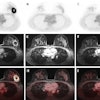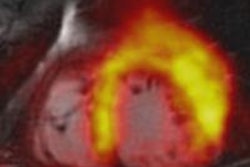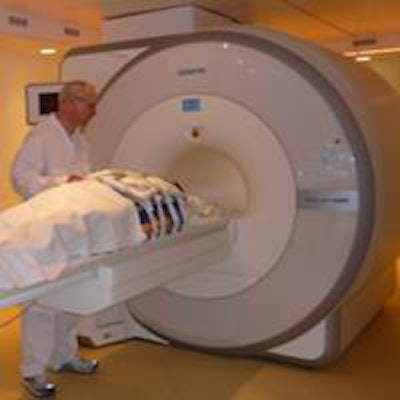
Simultaneous PET/MRI combines the sensitive molecular imaging of PET with soft-tissue contrast and functional information from MRI. A promising application for PET/MRI is quantitative brain studies, which demand high performance and stability from both modalities. A team from the University of Tübingen, Germany, evaluated the quantification accuracy, homogeneity, and stability of two PET/MRI systems.
To prevent adverse interaction between the two instruments, simultaneous PET/MRI systems employ avalanche photodiodes (APDs) instead of photomultiplier tubes (PMTs) in the PET detector. APDs, however, are highly sensitivity to temperature changes or bias voltage shifts. PET detectors based on APDs must therefore be systematically evaluated before use in demanding investigations.
"High stability of the PET/MR system is a prerequisite for functional brain studies," explained lead author and physicist Holger Schmidt, PhD. "Our main motivation was to test whether existing APD-based PET/MR systems are capable of performing dynamic PET scans using short half-life radiotracers, such as cerebral blood flow studies with O-15-labeled water. While standard PET and MR quality checks are already carried out, more detailed investigations of the feasibility of such studies are missing so far."
Quantitative performance
Schmidt and colleagues first evaluated the quantification accuracy of small lesions measured using two APD-based PET/MRI systems: the BrainPET brain scanner and Biograph mMR whole-body scanner. For comparison, they also assessed the Biograph mCT, a state-of-the-art PET/CT scanner (Investigative Radiology, 23 December 2013, online ahead of print).
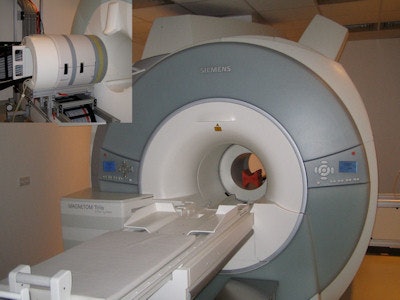 The BrainPET Insert (Siemens Healthcare) is placed inside the magnet bore of a clinical 3-tesla MRI scanner. Image courtesy of Armin Kolb.
The BrainPET Insert (Siemens Healthcare) is placed inside the magnet bore of a clinical 3-tesla MRI scanner. Image courtesy of Armin Kolb.The researchers used the three systems to acquire PET images of a cylindrical phantom containing eight spheres (with diameters of 4-8 mm) filled with [F-18]-fluoride solution at different positions inside the PET field-of-view (FoV). They calculated "recovery values" for all images, defined as the measured activity concentration divided by the decay-corrected true activity concentration.
The BrainPET system exhibited the highest recovery values -- up to 99.0% for 8-mm spheres -- and could better detect the smaller spheres. The whole-body PET/MRI, meanwhile, showed similar performance to the PET/CT scanner, with recovery values up to approximately 60% for the 8-mm spheres. However, the variability of recovery values for different sphere positions was higher for the BrainPET (up to 7.4%) than the PET/MRI (up to 4.1%) and PET/CT (up to 4.3%) systems.
The use of MR-derived (rather than CT-based) attenuation correction to reconstruct images from the whole-body scanner led to an underestimation in PET activity of up to 7.2%. The researchers also evaluated the effect of activity outside the PET FoV on PET quantification. For the whole-body PET/CT and PET/MRI systems, high activity concentrations outside the PET FoV had little or no influence on sphere activity quantification. The BrainPET, however, exhibited an activity-dependent recovery gradient, resulting in activity underestimations of up to 80% near the outside source. This is most likely due to erroneous scatter correction.
Long-term stability
To investigate the long-term PET stability of the whole-body PET/MRI system, the researchers recorded a 5-minute scan of a [Ge-68]-cylinder phantom 14 times over eight days. The PET detector showed good long-term stability, with standard deviations (SD) over the 14 measurements of 0.10%, 0.10%, 0.11%, and 0.03%, for prompt, random, and true counts and single count rate, respectively. The SD of the recovery values in the resulting PET images was 0.3%.
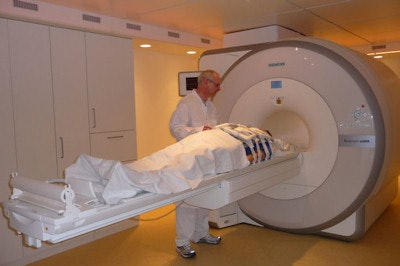 The Biograph mMR whole-body PET/MRI scanner from Siemens Healthcare.
The Biograph mMR whole-body PET/MRI scanner from Siemens Healthcare.Energy spectra of each crystal and position profiles of each detector block revealed no distinct deviations between the different measurements. This long-term stability implies that reliable PET measurements can be performed, with no problems due to temperature variations of the APDs causing gain variation. They also checked the influence of MR scanning during PET acquisition, finding no influence of simultaneous MRI on counts, count rates, or recovery values.
For functional MRI (fMRI) studies, the MR stability of the scanner must be tested according to the functional Bioinformatics Research Network (fBIRN) protocol. The researchers tested the stability of the whole-body PET/MRI system by scanning a stability phantom using an echo planar imaging sequence for blood-oxygen-level-dependent measurements. They performed fMRI with an idle PET system, with [Ge-68]-rod sources inside the PET FoV and with the PET system turned off and saw no PET-related changes. Measurements showed that the percentage fluctuation (0.07% for all PET states) and drift (between 0.16 and 0.28) were well below the fBIRN recommendations.
Schmidt and colleagues concluded that the homogeneity and accuracy of APD-based PET detectors were comparable with those of bulky PMT-based detectors. The stability of the whole-body PET/MRI system was also comparable with that of stand-alone systems, allowing for quantitative PET and fMRI measurements, assuming that suitable attenuation correction is applied.
As the BrainPET system showed problems with stability, the researchers plan to use the whole-body PET/MR system for future functional brain studies. "We are performing a clinical trial on brain tumors and are planning several trials for investigating different diseases using diverse short half-life radiotracers," Schmidt told medicalphysicsweb.
© IOP Publishing Limited. Republished with permission from medicalphysicsweb, a community website covering fundamental research and emerging technologies in medical imaging and radiation therapy.




